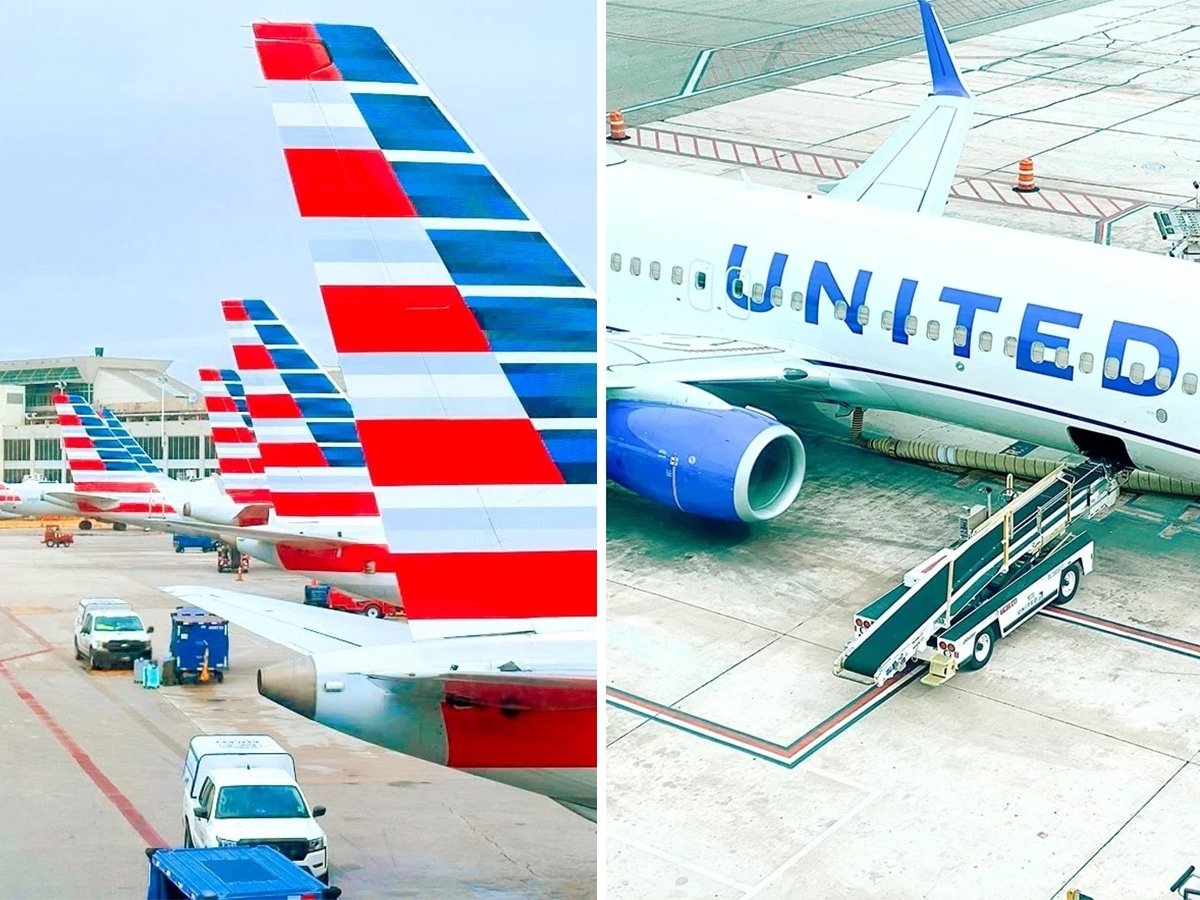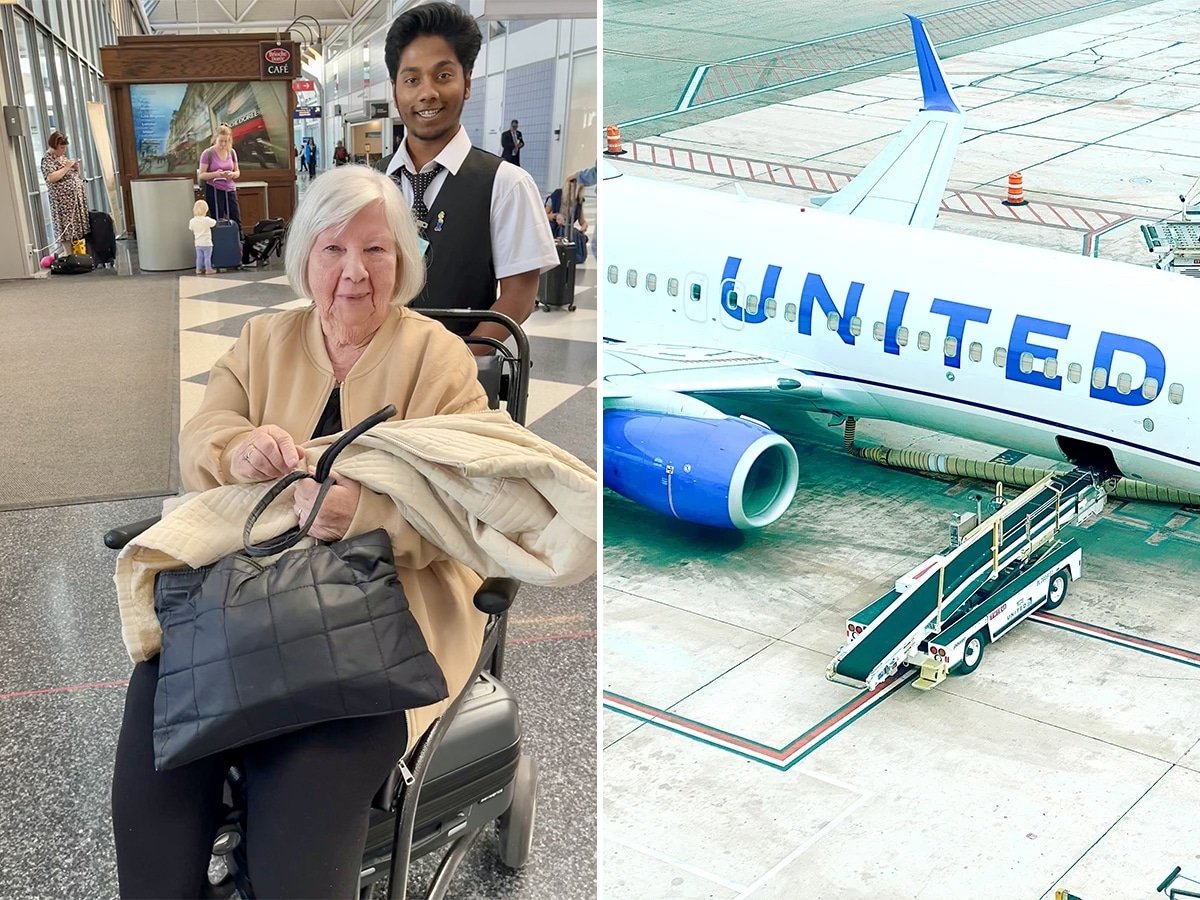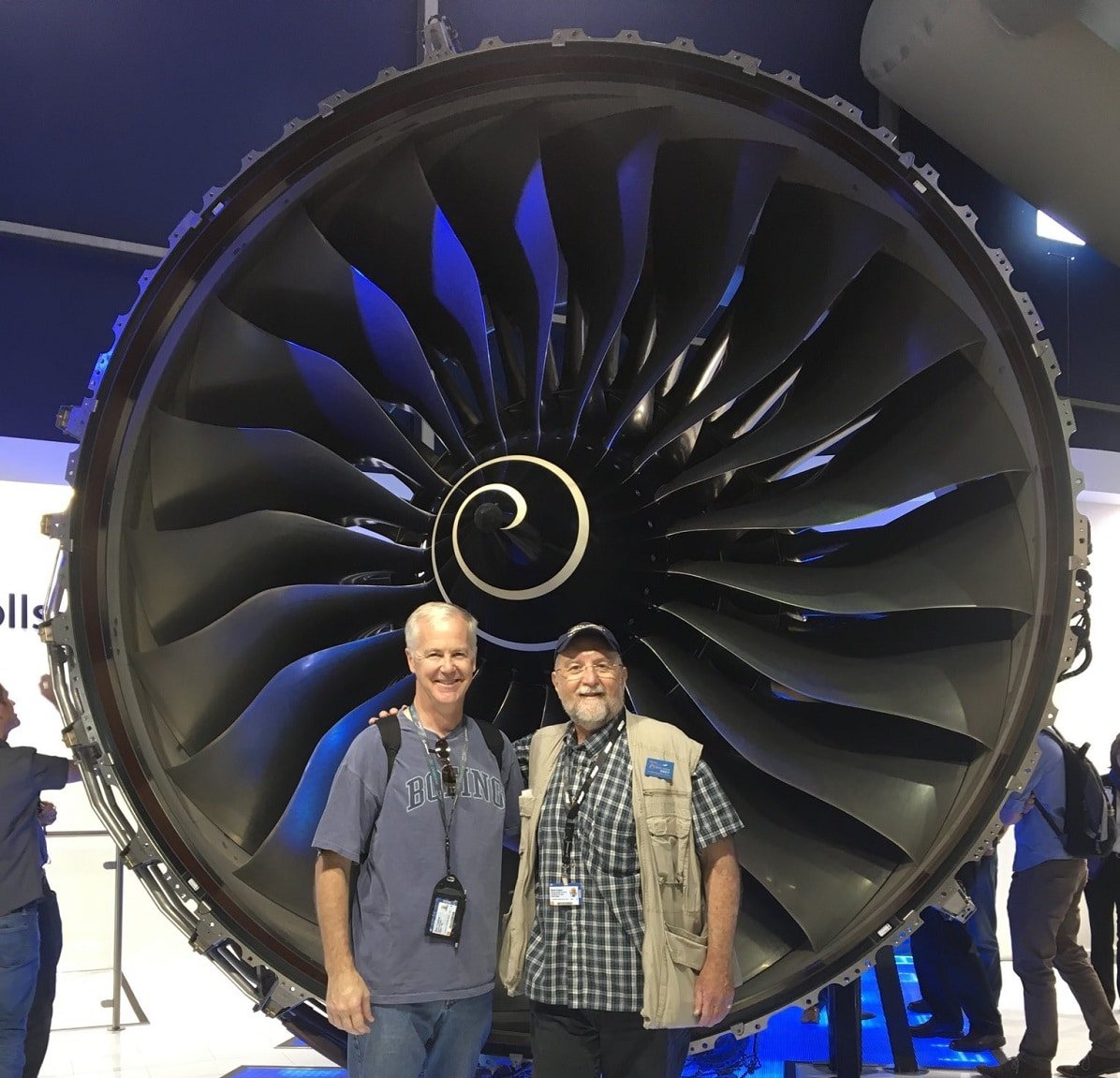 By Brian T. Coleman with Micah Engber
By Brian T. Coleman with Micah Engber
There are many ways to get from point A to point B. Traveling by plane is the most efficient way for many business travelers to get from where they are to where they need to be. Some business travelers do it so often they are referred to as road warriors. There are also people who travel as a leisure activity or hobby, non-business-related purposes. You know who they are, the ones who do it for fun / enjoyment / vacation… any other reason but business. These travelers just want to see as much of the world as possible. Both of these group will usually try to maximize the value of their travel by joining an airline frequent flyer program, and both groups, collectively, are often called Frequent Flyers.
In general, these Frequent Flyers most often choose to make use of a single airline to take advantage of a loyalty or frequent flyer program. Frequent flyer programs are offered by airlines with the intent to incentivize travelers to fly exclusively with that airline or its partners. The airline gets a loyal customer, and the customer gets rewards based on the number of miles flown and/or dollars spent.
The first frequent flyer program started in 1972 by Western Direct Marketing for United Airlines. This program recognized the miles each program member flew and gave them plaques and promotional items as rewards. A far cry from what today’s frequent flyer programs have evolved into.
Also in 1972, Texas International Airlines started the first true frequent flyer program that tracked individual members’ mileage and issued rewards based on distance traveled. In 1981, American Airlines launched its AAdvantage Program. Later that year, United Airlines launched its Mileage Plus Program, and Delta debuted SkyMiles. Just about every other airline followed with programs of their own. Many of these are still in existence in one form or another.
As frequent flyer programs grew in sophistication, tiers were added to determine passenger loyalty based on the number of miles flown or dollars spent. These tiers were created both as a marketing scheme, and for airlines to determine passenger loyalty levels. Tiers provided those that flew or spent the most with additional benefits, more incentives, and higher status within an airline specific program. These kinds of benefits made it advantageous to achieve the highest level of status possible.
Sometimes, as a travel year would come to a close, frequent flyers would find themselves a few miles short of either maintaining their status or achieving the next level status within their chosen program. To compensate for this, these frequent flyers would resort to a year end “mileage run.” A mileage run trip can be to anywhere in the world – as the goal is spending less than the cost of the direct purchase of miles for additional status and a higher tier as a frequent flyer. The destination doesn’t matter in a mileage run; only the acquisition of miles for status is important.
With this in mind, I ask the ultimate mileage run question… Would you be willing to fly 300,000 actual flight miles in less than 18 months to achieve the next level of frequent flyer membership? My answer is yes.
 As a road warrior for many years, I accumulated over a million miles in the American Airlines AAdvantage Program. With this amount of flying on American, I earned lifetime AAdvantage Gold Status. I have also flown over 2 million miles on United Airlines. This dedication to United has afforded me lifetime Premier Platinum Status with their Mileage Plus Program.
As a road warrior for many years, I accumulated over a million miles in the American Airlines AAdvantage Program. With this amount of flying on American, I earned lifetime AAdvantage Gold Status. I have also flown over 2 million miles on United Airlines. This dedication to United has afforded me lifetime Premier Platinum Status with their Mileage Plus Program.
In early 2022, I realized that if I flew just under 300,000 more miles with United, I would earn the highest status tier offered by United Mileage Plus, Premier 1K status for the rest of my life! Thus, it’s time for my longest mileage run (so far).
There are 4 tiers to the United Mileage Plus program: Silver, Gold, Platinum, and 1K. Actually, there is a fifth level called Global Services, but it is an invitation-only program offered to travelers who spend tens of thousands of dollars every year by purchasing high value business and first-class tickets.
Under current rules, achieving United Mileage Plus status requires a combination of Premier Qualifying Flights (PQF) and Premier Qualifying Points (PQP). PQF are issued based on the number of flight segments flown. PQP are calculated based on the fare price, including carrier-imposed surcharges, seat purchases and paid upgrades. (Yes, it is very confusing, I think it’s intended to be.)
As a United Mileage Plus member, one can earn Mileage Plus status through a combination of PQF and PQP or completing a higher PQP requirement. The chart below illustrates the requirements and some of the benefits of each of the four regular (non-invitational) levels of the Mileage Plus program:
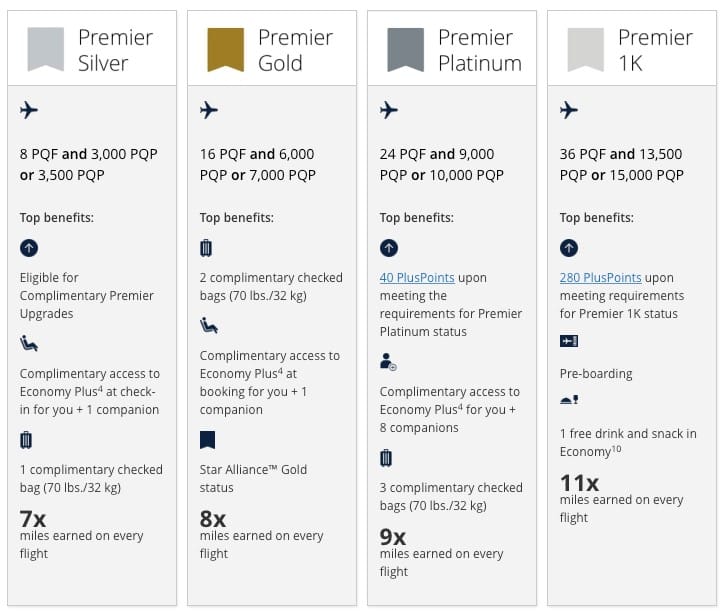
United has a more detailed benefits chart here.
This post will focus on the benefits of the highest level, United Premier 1K, as lifetime membership at this level is my goal. As you can see, there are many benefits at the Premier 1K level, but the benefits most important to me include the following (your priorities may differ):
- Pre-boarding – the ability to board the plane before anyone else,
- Free checked bags – up to three bags each weighing as much as 70 lbs.,
- Complimentary domestic upgrades – These upgrades clear up to 96 hours (4 days) prior to departure,
- 320 Plus Points – United’s currency for upgrades,
- No Change Fees on any ticket (fare) type,
- Complementary membership in the Clear identity verification program.
From my perspective, the most coveted benefit is the 320 Plus points that can be used for international upgrades. (More information about Plus Points is available here.)
International upgrades are most important to me because of the United Airlines Polaris Class service. Polaris service includes United’s lie flat business seat and the ability to use the United Polaris Lounge prior to departure and upon arrival. The Polaris Lounge is an upgrade from United’s regular Club Lounge and makes international travel that much nicer. (Information on Polaris Class and the Polaris Lounges can be found here.)
Now, getting back to the question… Why would I want to fly 300,000, actual butt-in-seat, miles on United Airlines to gain Premier 1K status for life??? What will this ultimate mileage run cost and is it worth it?
This is how I made my decision and includes some of the calculations I used. In general, this may be a good guide for you to take into consideration each and every time you decide whether or not to make a mileage run.
In January of 2022, my lifetime United Mileage Plus account was sitting at 2,707,517 miles. That meant I was only 292,483 miles short of the 3-million-mile goal and earning lifetime Premier 1K status. I knew I had a decision to make… was I going to embark on my largest mileage run to date or was I going to take the next few years and maybe get to this achievement sometime later in my life?
While the global pandemic was in full force, I asked myself some very serious questions in making this decision. Is it safe to fly? Is it worth possibly getting sick? What are the risks and consequences if I do get sick? What happens if I get sick outside the country? Many of these questions and thoughts rolled around in my mind… not to mention the cost of making all these trips, the cost to my bank account as well as the cost to my body.
Weighing all the considerations, I determined that the cost/risk was worth the end result. I calculated and determined that it would cost approximately $20,000 to fly the remaining miles I needed to reach the 3,000,000 mark. In addition, I decided it was worth the sacrifice to my body.
Here is a breakdown of the numbers:
Based on distance and price, two of United’s most cost-effective routes are Los Angeles to Singapore via San Francisco, and Los Angeles to Johannesburg via Newark. The Los Angeles to Singapore flight yields 17,590 actual flight miles and the Los Angeles to Johannesburg flight yields 20,870 round trip miles. The Los Angeles to Singapore flight costs on average about $800 and the Los Angeles to Johannesburg flight costs on average about $1,200.
| Route | Cost | Miles | Cost / Mile |
| LAX – SFO – SIN | $800 | 17,740 | 4.50 cents per mile |
| LAX – EWR – JNB | $1,200 | 20,870 | 5.75 cents per mile |
You’re probably thinking, if a flight to Singapore is less expensive, why not just fly to Singapore all the time? Well, two reasons. First, it gets boring after a while, and secondly, hotels in Singapore are very expensive compared to hotels in Johannesburg. In Singapore, a typical business class hotel can cost over $200 per night. The same quality hotel in South Africa may cost less than $75 per night. In order to mix it up a bit, I chose to fly to different cities for about the same out of pocket costs. I also chose to stay overnight as I’m no quite as young as I was when I was a road warrior and felt as though I needed the night’s rest in a hotel.
Moving along with the math: if I had to fly 300,000 miles and the average flight would yield 19,305 miles (20,870 + 17,740) / 2 = 19,305 average miles), that means I would have to fly 16 round trip flights. If the average ticket price is $1,000 ($800 + $1200) / 2 = $1,000), that means I will spend $16,000 on United tickets (16 flights * $1,000 ticket price = $16,000).
Then I added in airport parking, hotels, and miscellaneous expenses. I estimated this to be about $4,000, making for $20,000 in total expenses for the project.
If you’re following along carefully, you may have noticed that I left out food costs in my calculations. Well, that’s not exactly true. Years ago, I purchased a lifetime membership in the United Red Carpet Club, now renamed The Club. I can dine pre- and post-flights at The Club lounges. Additionally, many of my meals are served right on my flights. Lastly, when I chose to stay overnight at a hotel, because I have status with several hotel chains, I will almost always have access to a complimentary breakfast. As such, my food expenses will be very minimal if anything at all.
With the costs addressed, let us look at the benefits:
Most United frequent flyers will agree that one of the biggest values of United Premier 1K status is the ability to upgrade to Polaris business class by using Plus Points. This is the United term for the currency “spent” for upgrades. With United Premier 1K status, the airline will give me 320 Plus Points every year, for the rest of my life. Plus Points can be used for the following domestic or international upgrades:
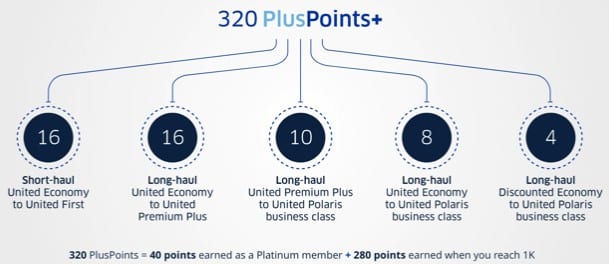
Using the charts above and below, you can see when I buy international Premium Plus tickets I will be able to upgrade ten segments to Polaris Business Class. That is 5 round trip tickets every year! Or I will be able to upgrade eight international Economy segments to Polaris Business Class… for the rest of my life. That is four round trip tickets very year!


On average, an international Premium Plus ticket costs about $1,500. An international business class ticket usually costs more than $3,500. Every upgrade is worth at least $2,000 to me.
If I fly four round trips a year, which I plan to do, that makes the upgrades worth at least $8,000 ($2,000 upgrade value * 4 trips = $8,000 value). Therefore, my payback will be less than 3 years ($20,000 expense / $8,000 value = 2.5 years). This is assuming United does not change the program, and I continue to fly at least 4 trips a year… which, between work and personal trips, I’m sure I can easily accomplish.
When flying on an international Polaris business class flight, I will also have access to the Polaris Lounge. As mentioned before, these lounges are a major step above the regular United Club lounge. The Polaris Lounge is only available to people who hold an international business class ticket.
In addition to Plus Points, on domestic flights, I will also receive the following benefits:
- Free meals and one free alcoholic beverage when traveling in Economy Class
- 11x Mileage Plus Miles vs. 9x as a Premier Platinum member
- Pre-boarding privileges
- 3 checked bags which can weigh up to 70 pounds each
- Free membership in the Clear identity verification program
- Higher priority on domestic upgrades as they clear up to 96 hours (4 days) in advance versus 72 hours (3 days) for Premier Platinum members
- No change fees for any type of ticket – paid or using miles
There are two additional benefits United provides to Premier 1K members that are vastly important to me. The first, the airline will provide a hotel room, at no cost, on weather related delays. Normally an airline is only obligated to provide hotel rooms on mechanical or other delays that are within the control of the airline. Weather related delays are not within their control and the airline is not required to provide overnight lodging when there are no more departing flights available that day. United always provides rooms for Premier 1K and Global Services members.
And perhaps the greatest benefit to me is the opportunity to designate one person a year to have the same Premier1K status. This is a very generous benefit and makes a marvelous gift to be able to extend to a spouse, family member, or anyone I choose.
Now there are many more benefits to the United Mileage Plus program, but they are just not particularly important to me. My decision to work toward achieving Premier 1K status was not based on any of the other benefits that haven’t been discussed here.
There is still one more thing. Since I determined the benefits are worth the expenses, I decided to document my adventures in obtaining lifetime Premier 1K status with United Airlines. If you are interested, you can join me on the journey.
With the help of my friend, occasional contributor and co-host on the Airplane Geeks Podcast, my Main(e) Man Micah Engber and I started a podcast, “The Journey Is The Reward”. On the show, we discuss the passenger experience of each of my flights, we share tips and tricks on the aviation industry, we talk about hotel frequent guest programs, answer questions from listeners, and generally kibitz about travel, aviation, airplanes, and anything else that comes to mind during the show. It’s great fun!
So where do I stand on achieving my goal? As of this writing I have 246,381 miles to go… mostly because I took the summer off. I simply did not want to travel when aircraft were 100% full and all the other worldwide airline industry issues that we’ve experienced this summer.
However, I do have several upcoming trips planned. The tickets are booked, and I have more destinations to visit. To date, I have purchased 174,822 miles of tickets for future travel. That leaves just 71,559 miles to fly by June of 2023. Can I do it? Absolutely! That is only four additional trips to South Africa or Singapore. Easy!!!
So I hope this will inspire you to think about your frequent flyer status and how you can use it to your advantage. If you fly with United, or any airline, please consider joining their frequent flyer program and take advantage of the various elite status levels and all the benefits that come with them.
And if nothing else, follow along on my journey with Micah and me, as we document and I participate in the world’s largest “mileage run” on The Journey Is The Reward Podcast.





